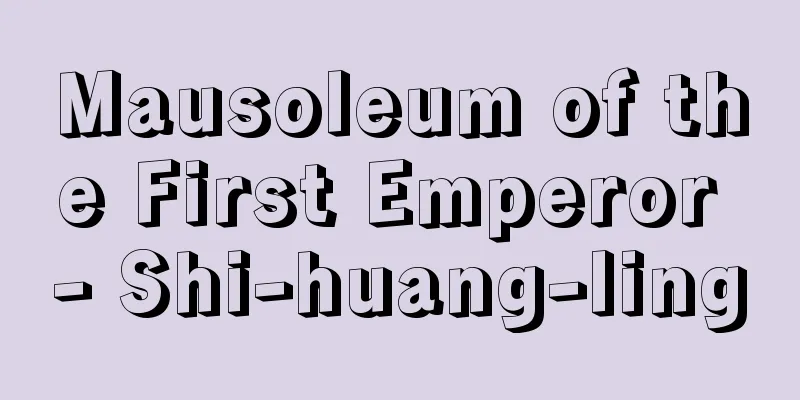Christian feudal lord

|
From the end of the Sengoku period to the beginning of the Edo period, the Sengoku daimyo were baptized into the Christian faith. Unlike the Edo period daimyo, powerful clansmen were also called daimyo, so there were a great number of them. However, when Christianity was banned by Toyotomi Hideyoshi and Tokugawa Ieyasu, most of them abandoned their faith, or at least outwardly adopted the same attitude as non-believers, and only a few continued to practice their faith. The first feudal lord in Japan to become a Christian was Omura Sumitada of Hizen, who was baptized in 1563 (Eiroku 6) and given the Christian name Don Bartolomeo. From the summer of that year to the following year, powerful clans and castle lords in the five Kinai regions, including Takayama Hida no Kami, Sanga Sancho (Yoriteru), and Ikeda Tango no Kami Norimasa, converted to Christianity. Among the early converts were Konishi Ryusa and Yukinaga, father and son, and Takayama Hida no Kami's eldest son Ukon. Omura Sumitada's older brother Arima Yoshisada was baptized in 1576 (Tensho 4), but died early at the end of the same year. Otomo Sorin of Bungo (Oita Prefecture), a representative Christian feudal lord on par with Takayama Ukon, was baptized as Francis in 1578, and shortly before that, his nephew and son-in-law Ichijo Kanesada had converted. After the Honnoji Incident (1582), when Hideyoshi built Osaka Castle, a kind of conversion boom occurred around the castle, and influential figures such as Gamo Ujisato and Kuroda Yoshitaka were baptized. This was largely due to the influence of Takayama Ukon. Hosokawa Tadaoki himself was influenced by Ukon but did not get baptized, but Tadaoki's wife Tama was baptized and became famous under the name Gracia. In 1587, Toyotomi Hideyoshi issued an edict to expel missionaries in Hakata on his way back from the Kyushu campaign, forbidding feudal lords from becoming Christians, but by this time Otomo Sorin, Omura Sumitada, Kyogoku Takayoshi, and Ichijo Kanesada had already died, and Takayama Ukon had declared his faith in defiance of Hideyoshi's wishes, and was stripped of his Akashi territory and daimyo status. At this time, those who did not incur Hideyoshi's wrath, such as Konishi Takasa and Yukinaga, Kuroda Takataka, Awi Ryosa, Arima Harunobu, Gamo Ujisato, Omura Yoshiaki, Kobayakawa Hidekane, and Ito Suketake, are presumed to have vowed, at least in appearance, to renounce their Christian faith. Among the many converts in Hideyoshi's later years were Kyogoku Takatsugu and Takatomo, Terasawa Hirotaka, Mune Yoshitomo, and Oda Hidenobu (Nobunaga's grandson), but all were forced to abandon their faith early on. Konishi Yukinaga's faith wavered for a time, but he is said to have continued to believe until his execution after his defeat in the Battle of Sekigahara in 1600 (Keicho 5). Takayama Ukon maintained his faith throughout his life, setting an example, and was exiled to Manila in 1614, where he died the following year. [Takeichi Matsuda] "Kirishitan Daimyo" by Takekazu Matsuda (included in "Exploring Japan in the Age of Discovery 3", 1978, Shogakukan)" ▽ "Kirishitan Daimyo" by Akio Okada (Kyoikusha History Paperback)" [References] | | | | | | | | | | | | |Source: Shogakukan Encyclopedia Nipponica About Encyclopedia Nipponica Information | Legend |
|
戦国時代の末から江戸時代の初期にキリシタン宗門の洗礼を受けた戦国大名。江戸時代の大名と異なって豪族をも大名と称したから、その数はかなり多いが、キリシタン信仰が豊臣秀吉(とよとみひでよし)や徳川家康によって禁じられると、彼らの大部分は信仰を棄(す)てたり、あるいは少なくとも表向きには異教徒と変わらない態度をとり、その信仰を貫いた者はわずか数名にすぎない。 日本で最初にキリシタンとなった大名は、肥前の大村純忠(すみただ)で1563年(永禄6)に受洗し、ドン・バルトロメオの教名を与えられた。同年の夏から翌年にかけて、五畿内(きない)では高山飛騨守(ひだのかみ)、三ケ(さんが)サンチョ(頼照(よりてる))、池田丹後守教正(たんごのかみのりまさ)らの豪族や城主が改宗した。小西隆佐(りゅうさ)・行長(ゆきなが)父子、高山飛騨守の長男右近(うこん)らが初期の改宗者に属する。大村純忠の兄有馬義貞(よしさだ)は1576年(天正4)に受洗したが、同年の末に早く世を去った。高山右近と並ぶ代表的キリシタン大名、豊後(ぶんご)(大分県)の大友宗麟(そうりん)がフランシスコの教名で受洗したのは1578年のことで、その少し前に宗麟の甥(おい)で女婿の一条兼定(かねさだ)が改宗している。本能寺の変(1582)のあと、秀吉が大坂城を築いたころ、同城を中心に一種の改宗ブームが起こり、蒲生氏郷(がもううじさと)、黒田孝高(よしたか)ら有力者が受洗した。これには高山右近の感化が大いに影響している。細川忠興(ただおき)自身は、右近から感化されながらも受洗しなかったが、忠興の妻たまが受洗してガラシャの名で著名となる。1587年に豊臣秀吉は九州征伐の帰途博多(はかた)においてバテレン追放令(宣教師追放令)を発し、諸侯がキリシタンになることを禁じるが、このときには大友宗麟、大村純忠、京極高吉(きょうごくたかよし)、一条兼定らは死去しており、高山右近は秀吉の意に背いて信仰の堅持を表明したので、明石(あかし)の領地および大名の地位を奪われた。このとき、秀吉の怒りに触れなかった小西隆佐・行長、黒田孝高、安威了佐(あいりょうさ)、有馬晴信、蒲生氏郷、大村喜前(よしあき)、小早川秀包(ひでかね)、伊東祐兵(すけたけ)らは、表向きにせよキリシタン信仰を棄てることを誓ったものと推察される。秀吉の晩年にも改宗者がかなり出たなかには、京極高次(たかつぐ)・高知(たかとも)、寺沢広高(ひろたか)、宗義智(そうよしとし)、織田秀信(おだひでのぶ)(信長の孫)らをあげることができるが、いずれも早く信仰を棄てることを余儀なくされた。小西行長は一時信仰に動揺をきたしたが、1600年(慶長5)関ヶ原の戦いに敗れ、処刑されるまで信仰をもち続けていたといわれる。高山右近は生涯信仰を堅持し、模範を示しつつ14年マニラに流され、翌年客死した。 [松田毅一] 『松田毅一著『キリシタン大名』(『探訪大航海時代の日本3』所収・1978・小学館)』▽『岡田章雄著『キリシタン大名』(教育社歴史新書)』 [参照項目] | | | | | | | | | | | | |出典 小学館 日本大百科全書(ニッポニカ)日本大百科全書(ニッポニカ)について 情報 | 凡例 |
<<: Christian version - Kirishitanban
>>: Christian Books - Christian Books
Recommend
Dorphin (fish) - Dorphin (English spelling)
A marine fish of the family Doradoidae in the orde...
Geometrical optical illusions
A type of visual illusion, in which the geometric ...
Koide Narashige - Koide Narashige
Western-style painter. Born in Osaka City on Octo...
Gabriel, Ange-Jacques
Born: October 23, 1698 in Paris [Died] January 4, ...
Flight of Icarus
...While Queneau's works have a folksy atmosp...
Half arm - Hanpi
A type of clothing for the aristocracy. It is an ...
"Sound of a Thousand Years" - Sound of a Thousand Years
..."Yachin Shugojo" depicts the downfal...
Ototachibana Hime
…Meanwhile, in Sagami Province, he was deceived b...
Pecaroecus
…Eskimos often eat them raw. The family Haematopi...
Necessary expenses - Hitsuyohi
The cost of preserving and managing something. (Fu...
Ring-porous wood
…There are three types of vessel arrangement, and...
Zonal index
An index that indicates the strength of air flow a...
Muzaffarabad (English spelling)
...The border with China on the Indian side remai...
Kadomatsu
It is a living tree that is erected inside or out...
Lux, H. (English spelling) LuxH
...In other words, the above reaction between the...








![Masuda [town] - Masuda](/upload/images/67cce580a7388.webp)
